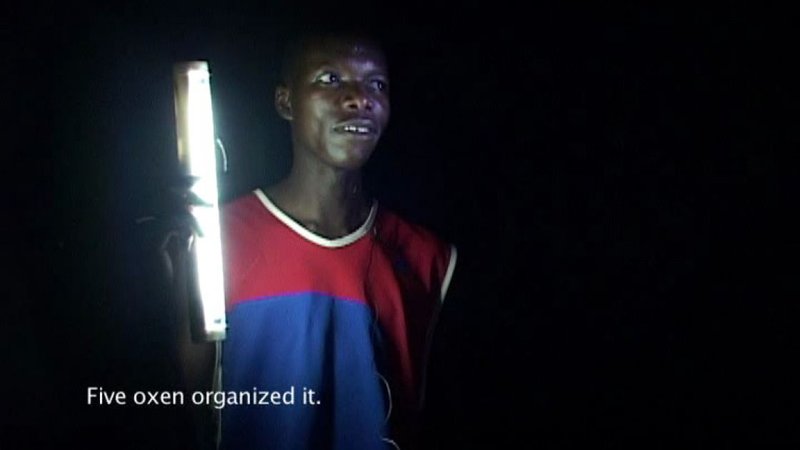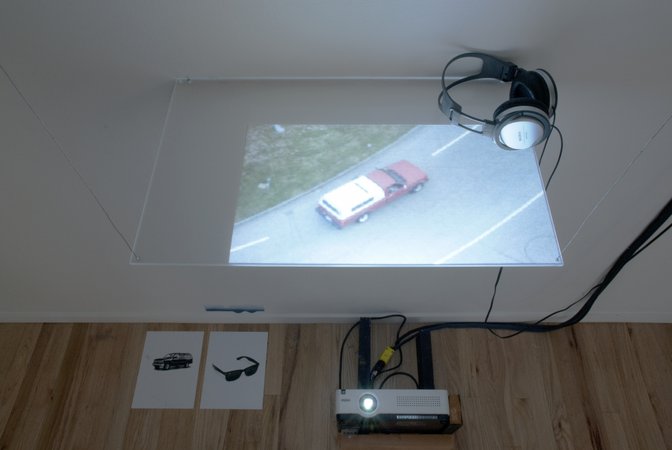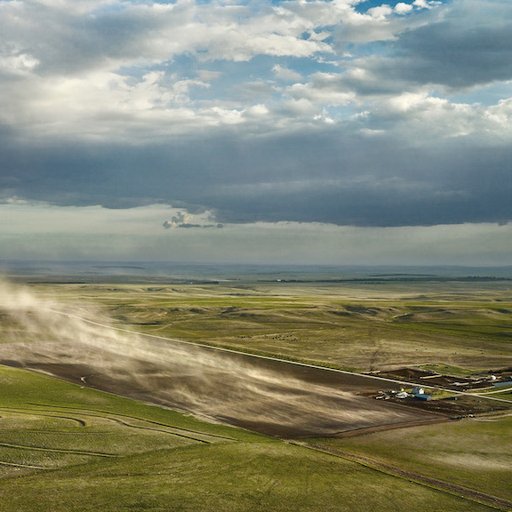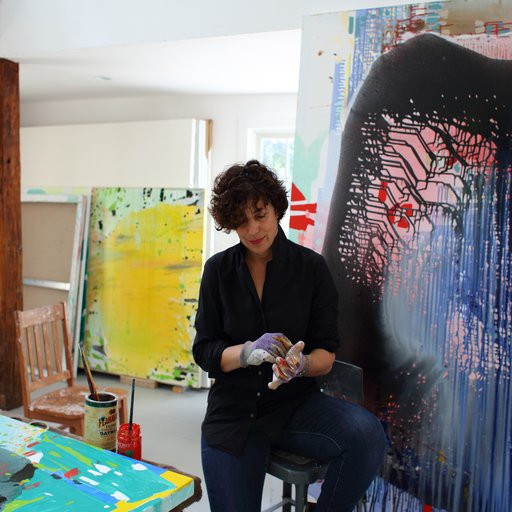In one well-known Indian parable, a group of blind men are tasked with describing an elephant. Each grabs hold of a different body part—the trunk, the tail, the tusk, and so on—and each portrays the creature in a radically different way. The French-Algerian artist Neïl Beloufa ’s film The analyst, the researcher, the screenwriter, the CGI tech and the lawyer can be read as a contemporary reinterpretation of this old tale; the professionals from the title all watch the same bit of ambiguous footage—an aerial shot of a truck weaving through Vancouver traffic—and are asked to explain what’s going on. Like the blind men before them, the members of this group can’t help but to interpret this experience in terms of what they already know, a process that leads them invariably towards increasingly divergent readings.
Beloufa has dedicated himself to exploring precisely this ambiguity of interpretation. His films proceed from simple tasks the young artist gives his subjects—talk about the future in the present tense, for instance, or describe your ideal city—that he then edits into deadpan documentaries that render these fantasies as realities. It’s a gesture of documenting fiction not unlike Joshua Oppenheimer ’s genre-defying 2012 masterpiece The Act of Killing , and the results are in turns amusing and eye-opening.
Beloufa does not stop with his films, however. Instead, he shows them in the context of sprawling installations made of Plexiglas, plywood, and his signature foam walls, usually with some not-so-subtle pop-culture references thrown in for good measure. The result is a kind of armature for the films, a layering that expands the scope of his moving images even as it obscures them.
The 30-year-old artist is quickly gaining recognition for this work, with recent solo shows at ICA London and the Hammer Museum and an upcoming project at MoMA scheduled for March 2016. For Beloufa, the success already seems short-lived; as he says in the following conversation with Artspace’s Dylan Kerr , failure is always an option, albeit one that he welcomes with open arms and a “romantic” disposition.
 Still from
Kempinski
, 2007
Still from
Kempinski
, 2007
How did you first get interested in making films?
I have a family history with film. My mother was an editor when I was a kid, but then she stopped. My father made one movie before I was born, but then he stopped. Maybe it was just in the culture of my home.
I wanted to make cartoons, but schools of animation didn't want me because I was a bad drawer. I ended up in an applied-arts school, training to be a graphic designer, and I was bored. That’s when I went to the video section. I got caught up in the art world because I made a video in Mali called Kempinksi . It wasn't planned to be an art piece—it was a documentary that somehow got into the art system.
Kempinski proceeds from a simple idea: asking subjects you encountered just outside Bamako, Mali's capitol city, to speak about their vision of the future in the present tense. How did you come up with the speculative frame for this piece?
It was to piss off my teachers, basically. I was in my third year of school, and they sent us to Mali to make documentaries. I rejected it because I’m Algerian—it felt to me that they had a paternalistic point of view. I thought they wanted us to document hard lives or something, which wasn't really true. Either way, that was my rebellious move. I was like, “OK, I’m going to make a documentary if you want me to do one.” It was all about fucking with them. I wanted the people I was filming to say “fuck you,” basically.
Your works often seem to be documenting fiction, where you set up artificial scenarios in order to show what really happens in them. How do you think about the interplay between the artifice of the question you’re asking and the artifice of the documentary you’re filming?
I've thought about the history of the moving image since I was really young. I think my innocence was broken super early when it comes to fiction. I never had a suspension of disbelief. I analyze—I don't cry, and I don't believe it. I just don't buy it.
I’m always trying to play with this relationship between yourself and the fiction you see. It’s something you don't believe but you kind of still believe, or you play with, or you have a connivance with. The film is not happening on the screen—it's happening in between, in your relation to it. It fights its own authority, it fights propaganda, it fights commercialism.
You’re exploring old questions about the power of the filmmaker—the fascistic control the director has over what the viewer sees and thus believes.
I don't like authority. I’m interested in creating an authoritarian system, and then breaking it. I like displaying my authority in order to challenge it.

In these situations where you are asking people to play along with your conceit, whatever it might be, have you had the subjects that you are filming push back against this authority?
It's a game. Those kinds of rules or systems concern half of the works, but what I like with those works is that it's always a game. People fight against me because they know I want to make something, and I fight against them because I want to control them even while I give them freedom. That's what creates the narration or the tension. They don't want to give what I want.
How does this game translate into the gallery once you’ve done your job as a filmmaker? How does the power dynamic of that game shift from artist-subject to artist-viewer?
I guess that’s for you to say. My goal is for people to get caught, but not believe it. That relation is interesting to me. I want you to have questions, political questions, after you watch them. Sometimes I lie, but most of the time it's just playing games. It's never straightforward and it's never yes or no. It’s up to you. I’m making a proposition, and you can say no and you can say yes and hate me.
There is that racist film, World Domination—
Where you asked people what they would do if they were president?
Yeah, and they get super violent. There is a fascination towards it, but I also got a reaction from people saying, “What the fuck are you doing? You can't do that.” That's what I like, that thing where you are free to buy into it or not. Because I show the system, I give you the keys to not buying into it, and that produces something else entirely.
All of your films have very specific conceptual frames, which are the games we’ve been talking about. On the other hand, the sculptural objects that you create around these films have their own presence. They don’t really help in relating the films as clearly as possible—they add layers, both physical and metaphorical, between the viewers and the films. Why create these additional layers?
When they work, these objects open up the meaning of the film, but sometimes they reduce its strength. An example of one of those that works is the installation from Counting on People , because the structure—which looks like a shitty condo, or an Apple display—grounds the idea in society. You don’t even need to listen to the film.
More and more in my practice, the items become the document. The films become more and more about fiction, and less and less about documenting. The objects ground the films now, here in front of you. It’s the same way that you look at your bed and your laptop when you watch a movie—they participate in that movie. When you watch a porn, you have the contrast of your shitty, empty bed with that utopia of easy sex. My work parasitizes life and brings your experience more towards how you relate to life in real time. My shows should be a mess, where you can decide what you want to look at. It’s about making a world without hierarchy.
It seems like your work is attempting to create a horizontal platform, where all the elements—the films, the objects, your actors, and yourself—are being placed onto an equal level.
We’re in a world where there’s no hierarchy between imagery or fields. That’s disappearing. There’s now a new job, which is curating. That person is not an expert, but he’s an expert on everything. He’s YouTube, he’s Wikipedia. He can talk about soccer, philosophy, art, and music, all without being a soccer player, a philosopher, an artist, or a musician. He’s a new kind of author.
I’m not a sculptor, I’m not a filmmaker. I’m an editor. I edit content, I edit voices, and I edit ideas. That’s how I work, and that’s how I try to build something that goes towards this direction. Something might look autonomous, so I add something that kills it—but then you can watch that alone or you can see both. I like stuff that can go here and there and keep that line of unbalancing meaning, keep the openness of it.
 Installation shot of
horizontal usb knight, work out, macho dream of a wedding, his length
, 2014. Image courtesy of Mendes Wood DM.
Installation shot of
horizontal usb knight, work out, macho dream of a wedding, his length
, 2014. Image courtesy of Mendes Wood DM.
There’s a real economy of means in your work—many of your films are populated with amateur or untrained actors, and the materials you use to build your installations are generally stuff anyone can get in a hardware store. Is this sourcing of your materials part of your process, or is it a function of what you have available?
It’s both. I’m interested in standardization. My sculptures look like they’re made with standardized, industrial materials, but they’re unique because I peed on one and put a cigarette out on the other. I like that they play and display that game, because my point of interest and field of expertise is always representation and how we represent something, not the thing in itself. The simulacra, or something like that.
In terms of actors, I like when something reflects on its time without using reality. The fictional stuff that I did with amateur actors talk more about our society than if I was filming his life. It’s political, also. I made one film in L.A. called Production Value, where I play the wannabe Hollywood director with wannabe actors that were real gangsters or real cowboys. I told them, “OK, I’m making a feature film, with a set and everything just like in Hollywood. Make the movie you want.” I gave the exact same amount of time to every community I was working with. In that way it’s a democratic movie, but I don’t believe in democracy. I just display what it means.
You’re working with some serious issues of real art-historical and political import—representation, the relation of objects to meaning, the redistribution of wealth—but your initial approach seems to be through humor. What role do jokes have in your work?
My form is based on jokes, but I can talk about something serious with jokes. I like when people go into a show, look at something, and don’t know if they should laugh or not. Sometimes they laugh and then feel guilty, and I like that too.
I don’t think we should be too serious about art, even if it’s super important. I think the vague or fake seriousness about it is bullshit. When you’re clever with something from pop culture, with something that makes you laugh or that my grandmother can watch, you’re way stronger than any bullshit complicated intellectual statement. Sometimes representations of the intellectual don’t give you the opportunity to be on one side or the other. If you see a good book in a bad vitrine, what does it mean? You’re not talking about thinking—you’re talking about the idea of thinking. It’s seductive for people who want to look clever.
The jokes are my way of saying I’m stupid, that I don’t think art should be clever and that I’m not smart enough to quote [philosopher Emmanuel] Levinas, but they’re also super pretentious because they say that I don’t think I need grounding to make something relevant. Like everything else, it’s both at the same time.
 Installation shot of
Production Value
, 2013
Installation shot of
Production Value
, 2013
A lot of what you’re saying sounds like you have a real aversion to the pretension and business-oriented approach of today’s art world. How do you reconcile these feelings with the fact that it’s precisely this world that has allowed you the freedom to pursue your work?
I’m part of it. When I was younger, I was that really intense person who says, “Fuck money, fuck power.” A curator friend of mine—one of the few people that I owe—gave me an important show for that time in my career. There was a dinner, and she placed me at a table with people that cock-blocked me—directors of museums, people like that. I said, out loud, “I won’t sit with these traitors—I’m not that kind of guy. I won’t sit at any table if the people that actually worked on the show don’t sit there too.” My friend took me to the side and said, “If you don’t want to come, don’t come. It’s easy. You don’t have to do your show.”
I have an aversion to authority and systems that look fixed, and I don’t think the world is in good shape, but I’m not helping anything. I’m not changing it. Art is the laboratory for everything else in society. We’re totally deregulated, so every system can work in it. It’s always pushed further because there is no law.
For a relatively young artist making works that aren’t exactly collector-friendly, you’ve enjoyed a large amount of recognition in the field. How does this kind of early success affect the way you’re making or thinking about your work?
I’m not going to speak against it, because I live off of it and I’m super happy to be so lucky, but, hypothetically, I don’t think you should theorize what someone does before they're 40.
I think a lot of people would probably agree with you. Why do you think that?
Because the work is still in the making. I’m not going to complain about it, because I’m playing with it and I’m happy to work, but I wouldn’t feel hurt if someone says that because I agree. It does put a lot of pressure on me, and I’m caught up in questions that I shouldn’t be caught up in, but it’s also nice because I’m learning a lot.
I’m a shitty businessman, but I’m learning about economics. I’m talking to bankers, which provides an interesting image of our time. Sixty percent of my time is being stressed about money, but as long as it allows me to produce, I’m fine. And it does allow me to produce. Last year we did four films, including one serious feature, all self-produced. As long as no one is telling me to stop and I’m not feeling like a gambler who’s gambled too much, I’m going to take and make. It’s a chance that doesn’t come often, and it’s going to stop soon.
Do you think there will come a time when you have to stop?
Yeah. At some point, people get bored, and I can’t produce that much. I think that people make guys like me produce more in five years than some people do in their lifetime, which is crazy, so at some point it’s going to be dry, for sure. Maybe I’m already dry, but I’m trying not to be. It allows me to reevaluate my system all the time.
It also gets harder the more you grow. I thought being super autonomous and not needing anyone to do something was good, but the more you gain power, the more you submit to it. It’s an interesting relation, because I’m less and less autonomous while also gaining autonomy. It’s interesting and stressful, but that’s the game of society.
 Secured Wall
, 2015. Image courtesy of Mendes Wood DM.
Secured Wall
, 2015. Image courtesy of Mendes Wood DM.
You’ve said before that some of your films and projects have failed. How do you work with failure?
The systems I put in place are made to fail. It's romantic—it's a complex I have.
What do you mean by romantic?
It's romantic cynicism. For instance, Kempinksi was based on a grammatical mistake. It's a joke but it's not—it's super serious. I know people won't buy it. I know they won't think it’s science fiction, and I'm playing on that. Each every project, even sculptures, shows me as a wannabe artist, a wannabe filmmaker. Success is communication, and I think communication is my enemy as an artist.
Why is that?
I don't know. That's how I define my position in the role. I work with failure because I don’t know how to succeed. I have no answer.
My enemy is efficient, is industrial, is communicative, is designed. It's something that you don't think about when you use it—that's my enemy. My way of fighting is to fail, or to play with it. It’s partly just having a sense of humor, but it’s also a romantic belief in questioning something. An artist’s role is to step back and be in between, to be in society and outside at the same time. I want to bring people to that same line, where they don’t know if they’re in or out. My tool for doing that is failing or betraying or showing problems.
What’s an example of a work of yours that has failed?
The biggest failure of my life was a project at the Palais de Tokyo. I tried to make an economic system inside the gallery. We didn’t have the budget to make anything besides videos, so we built a set in the space and shot three movies on-site. Then we organized a party with 700 people to destroy the set, so people would work for free for me to create my materials. Out of that party, where people were working for free and paying for drinks, I would have money to work and do sustainable development with the materials that they destroyed. From that, I would have enough money to pay a bribe to the director of the Palais de Tokyo—I wanted a picture of me paying the bribe.
I ended up in debt. I was losing money because people started to understand the password system for the drinks. We weren’t allowed to sell the alcohol, so we had a system of paying for a password to get a drink, and people started to fuck me over. People also stole stuff from the museum that I had to repay, so in the end I was in debt. It was an attempt to create sustainable development from a corrupt, Facebook-style participation economy where people think they’re having fun while they’re actually working for me, and it was a complete failure.
That’s really beautiful, actually.
Yeah. I was really depressed for two months after the show, but I learned a lot. I lost everything trying to rely on someone else, so I decided to find some other way. It’s going to happen again—me going broke and then finding a new solution.



























